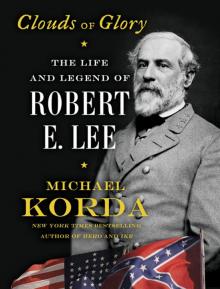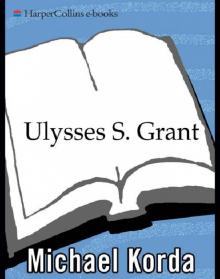- Home
- Michael Korda
With Wings Like Eagles: A History of the Battle of Britain Page 10
With Wings Like Eagles: A History of the Battle of Britain Read online
Page 10
This subject had already come up during a dramatic early-morning telephone call between the two prime ministers, Paul Reynaud and Winston Churchill, on May 15, only five days after the king had asked Churchill to form a government. “We have been defeated,” Reynaud said, in English, when Churchill picked up the telephone by his bedside. “The front is broken near Sedan.”3 The way to Paris, Reynaud warned, was open.
The next day, following the grim news of the surrender of the Netherlands, Churchill flew to Paris to meet with Reynaud and the French war cabinet at the Quai d’Orsay. The meeting was not made any more cheerful by the sight, through the window, of “venerable officials pushing wheel-barrows of archives” of state documents into the garden and dumping them into “large bonfires,”4 from which the smoke rose high above the French ministry of foreign affairs. The glum admission of the French commander in chief, General Gamelin, that he possessed no strategic reserve with which to stage a counterattack, and his obvious belief that the war was lost, was followed by a vigorous demand from him, and from all the French present, for more squadrons of fighters from Britain. General Gamelin pointed out that only the fighters could stop the German tanks—a belief which was to be repeated at every Anglo-French meeting until the end, and stubbornly contradicted by Churchill. It is difficult to see how Gamelin imagined that fighters could stop tanks. The Mark I Hurricane had no provision for bomb racks; nor had the pilots any training in attacking targets on the ground. Also, the .303-caliber bullets of the British fighters’ eight guns would have bounced harmlessly off a tank’s armor. What the French needed to do was to dig in their own field artillery, the famous soixante-quinze, which had served them so well in World War I and which, with its rapid rate of fire, high velocity, and flat trajectory, was still capable of disabling a Panzerkampfwagen II or III, the type of tank that then constituted the bulk of the German armor. Fighter planes, even if the British had them in abundance, would not have stopped the advance of the German panzer divisions, although they might of course have helped with the Stukas. However, whatever differences existed between General Gamelin, Prime Minister Reynaud, and Monsieur Daladier, who was the minister of national defense and war (and the differences were considerable), on this subject they were as one—now was the moment to send every fighter to France. Churchill, during the telephone conversation from his bed with a distraught Reynaud the pervious day, had agreed to send four more squadrons of Hurricanes to France. Now, faced with the signs of collapse all around him, both in the room and outside in the garden, and moved by the plight of the French, he agreed to seek the British War Cabinet’s consent to send another six squadrons as well. “It would not be good historically if their requests were denied and their ruin resulted,”5 Churchill cabled from the British embassy, and late that same night he was driven to Reynaud’s apartment to tell him that all ten squadrons would be sent the following day. Reynaud had already retired to bed and emerged in his dressing gown, leaving his mistress, the formidable Hélène de Portes (whom one wit described as “the only man in the government”), in the bedroom to listen behind the door.
It was a moment of high emotion, perhaps the most dramatic and positive in a succession of increasingly difficult and depressing meetings between the French and the British prime ministers; but on the other side of the Channel, when he heard the news, it alarmed an already apprehensive Air Chief Marshal Dowding, and set off an equally difficult disagreement between the British prime minister and the Commander-in-Chief of Fighter Command.
Probably no subject in history has been written about in such detail as the relationship between the British and French governments from May 10, when the Germans attacked, to June 22, when the French government, by then headed by the aged, defeatist Marshal Pétain, signed an armistice with Germany. In the English-speaking world, the account of those calamitous events that has fixed our view of what happened is Winston Churchill’s. His was, after all, the central role in the drama; he himself drafted (with considerable care and thought for the opinion of posterity) most of the important documents and cables on the British side; he alone survived the war victorious to tell the story. Nearly half of Their Finest Hour, Volume II of Churchill’s The Second World War, is devoted to the fall of France, and they are perhaps the most dramatic and compelling pages in the entire six volumes, as full of light, shadow, emotion, and human detail as history can be, a Shakespearean tragedy rendered in the Gibbonesque prose style of which the prime minister was the undisputed master.* On the British side, almost everybody else who was involved has written about it, in memoirs, published diaries and letters, but it is Churchill who still dominates the scene now, as he did then—after all, it was not only “their” finest hour, it was his.
A whole book—indeed a sizable and distinguished one†—has been written about the way Churchill subtly and sometimes not so subtly shaped his description of events and artfully edited the documents at his disposal when it came time to write “his” history of the war. Nowhere in the six volumes and nearly 2 million words of The Second World War does he go to more trouble to build a case for himself than on the subject of the fighter squadrons he wanted to send to France, and Dowding’s objections to doing so. Indeed, it is perhaps the only place in the whole massive structure—which won him the Nobel Prize for Literature—where one can hear the stage machinery creaking and clanking as Churchill tries to escape blame and diminish the strength of Dowding’s opposition, one of the very few episodes about which Churchill appears to feel, if not shame, then at least a certain embarrassment.
To understand why, it is necessary to consider the size, scope, and purpose of the RAF presence in France, to which, from the very beginning, Dowding had forcefully presented his objections regarding his fighters. It had always been the government’s intention to send a British Expeditionary Force (BEF) to France in the event of war with Germany, and it was also a firm commitment made, with whatever reluctance, to the French. The BEF, which would eventually include nine divisions, was to take its place in the “line of battle” on the French frontier, centered on Lille, with the French Seventh Army on its left and the French Ninth Army on its right, and in the event of a German breach of Dutch and Belgian neutrality, was to advance to the Dyle River and hold a line from Louvain to Wavre.* It was understood that the BEF would need its own air support, and to supply that the RAF had created what became known as the Royal Air Force Component of the British Expeditionary Force (a bit of a mouthful, sometimes shortened to “the Component”), to consist of five squadrons of Lysanders for reconnaissance and communications work, four squadrons of Blenheim twin-engine light bombers, and four squadrons of Hurricanes, to be increased by six more “if necessity arose.” All these were based at airfields in northern France, behind the BEF. As it became apparent just how weak the French Armée de l’Air was, a further British force, known as the Advanced Air Striking Force (AASF), was dispatched to France, with ten squadrons of Battle single-engine bombers and twin-engine Blenheims, and two further squadrons of Hurricanes, all to be stationed farther south, behind the Ardennes and the Maginot Line, and to serve as a bombing force to support the French and British armies. Together, these made up a considerable though ill-assorted force of aircraft, spread out over dozens of widely separated airfields in northeastern France. Both the Component and the AASF came under the overall command of Air Marshal A. S. Barratt, who in theory could, if he thought it necessary, “request” assistance from Bomber Command in Britain.6
Bomber Command, as it happened, was as reluctant to commit its medium and heavy bombers to supporting the Allied Forces in France against German attack as Dowding was to release his Hurricanes—it took the view that the best way for its bombers to support the Allied armies in France was to bomb the vital points of German industry.* This was the theme song of “strategic bombing,” which would be replayed again and again from 1940 to 1945. (Though the air marshals were loath to admit it, the big bombers had in any case very little chance of hitting small tar
gets near the front line, like bridges or road junctions, by day, and none at all at night, and were unlikely to survive against sustained flak and fighter attack.)
The reluctance of Bomber Command to come to the rescue of Air Marshal Barratt if requested to do so was nothing compared with Dowding’s feelings about letting even a single one of his Hurricanes get out of his hands. At the very beginning of the war, Dowding had been indignant to learn that four squadrons of his fighters were to go to France as part of the Component Force, and even more upset when he discovered in “the small print” that six more might be taken from him “if necessity arose.” He was astute enough to know that necessity would almost certainly arise, and protested vehemently, in person and in writing, to the Air Council, the Secretary of State for Air, and the Chief of the Air Staff, but got nowhere except to confirm in everybody else’s mind the notion that he was difficult, unreasonable, and the victim of an idée fixe. Dowding was doubly indignant because he had always made it clear that the absolute minimum number of fighter squadrons he required for the successful defense of Great Britain was fifty (this number was later raised to sixty), and he had been given to understand that the four squadrons for the BEF would not leave Britain until he had his fifty squadrons in place. Instead, they had been removed while he did not yet have even half that number, and as an experienced military bureaucrat he knew that once they were out of his hands, he would never get them back.
Also, as he constantly tried to explain, the fighters and their pilots were only a part, admittedly the most glamorous part, of an intricate and well thought-out system, in which numerous participants played vital roles: the young women drawing up the plots at the radar stations; the “beauty chorus” moving the markers on the big board at Fighter Command Headquarters; the GPO telephone engineers installing and keeping in good repair the hundreds of buried telephone lines from Bentley Priory to and from the Group commanders and the radar stations; the “boffins” constantly perfecting and improving the radar network; the civilian ground observers, with their helmets and their binoculars; the fighter controllers; and even the men driving the big Scammell trucks (known as Queen Marys after the giant ocean liner), who transported damaged Hurricanes and Spitfires to civilian-staffed regional repair centers where they could be repaired and sent back to fighting units quickly. The fighters on their own, without this organization in place, could not save Britain even if Dowding had his fifty (or sixty) squadrons, and could certainly not save France.
Sending Hurricanes to France was, in Dowding’s view, turning on a tap which the politicians and the Air Council would never have the courage to turn off, and through which Britain’s lifeblood would pour. Removed from the structure of Fighter Command, spread out on makeshift airfields with inadequate maintenance facilities, and sent into battle without radar or ground control to guide them, the Hurricanes and their pilots would simply be wasted. On the subject of this vital point, nobody wanted to listen, and no matter how hard Dowding tried, Churchill never grasped it, or perhaps, to do the prime minister justice, he never wanted to grasp it—a fact it might be, but it was an inconvenient fact, and if he wanted to keep France in the war he could not afford to accept it.
As early as October 1939, Dowding had clashed sharply with the Chief of the Air Staff, Sir Cyril Newall, who had wanted him to make advance preparations so that fighters could be sent to France quickly, if necessary. Dowding smelled a rat, and replied, crushingly and with no hint that he was willing to compromise, that “the French difficulties are largely due to the pathetic inefficiency of their Interception System. I have not been told what steps they are taking to set their house in order, even at this late date.”7 Far from sharing Newall’s belief that Britain could lose the war in France from a lack of fighters there, Dowding believed that France was a lost cause anyway, and that Britain could survive the French defeat if—and only if—he had enough fighters to protect British ports and aircraft factories from the enemy, and to maintain air control over the Channel.
Events in France between May 10 and the evacuation of Dunkirk just over two weeks later served to confirm Dowding’s opinion. The French air force was incapable of making any impact on the enemy, and indeed hardly even tried; and the RAF forces were rapidly destroyed. On the very first day, of the thirty-two Fairey Battles sent to bomb the advancing German columns (over the vehement objections of General Gamelin, who wanted to avoid “a bombing war” for fear of German reprisals against French cities), thirteen were shot down and all the rest severely damaged. A force of Battles sent to attack the bridges over the Albert Canal at the urgent request of the Belgians was completely destroyed—the raid accomplished nothing but the subsequent award of two (posthumous) Victoria Crosses. By May 14 General Gamelin, now reacting with something approaching panic to the speed and unexpected direction of the German advance, had changed his mind and was begging the RAF to bomb the bridges over the Meuse River. Although it was well known that a bridge is almost impossible to hit from the air, and that the only reliable way of destroying one is to mine it and blow it up before the enemy reaches it, the French had neglected to destroy the vital Meuse bridges. Air Marshal Barratt nevertheless obliged General Gamelin with a raid in which forty out of seventy-one bombers sent were shot down—the highest “rate of loss”8 that the RAF had ever experienced in an operation of this size. The operation did almost no damage to the bridges, and slowed the German advance down by at best a few hours. The Hurricanes sent to protect the slow, vulnerable Battles and the poorly armed Blenheims performed prodigies, but, inevitably, Dowding’s darkest predictions had come true—the forces of the RAF in France were being destroyed piecemeal for no possible gain. The tap had been turned on, and nobody wanted to face the political consequences of turning it off.
Four squadrons of Hurricanes had been sent to France at the start of the German attack, in addition to the six that were already there. By May 13, as anguished demands for fighters poured in from the French, as well as from the foundering Dutch and Belgian governments, the question of sending more Hurricanes to France had become the hottest of political hot potatoes. It was discussed at a meeting of the War Cabinet, where the new Secretary of State for Air, Sir Archibald Sinclair, who had been Churchill’s second in command during the brief period when the prime minister had commanded the Sixth Battalion of the Royal Scots Fusiliers in Flanders in 1916, reminded the War Cabinet of the Air Staff’s estimate that sixty squadrons were required to defend the country against German attack, and that only thirty-nine were available.
When it came time to write his own version of these events, in 1948, Churchill naturally chose to portray himself in a concerned and judicious role, balancing the demands of the French against the requirements of the Air Staff, but in fact most of those who were there that day remember him as a glowering, overbearing presence, at his most obstinate and difficult. Against this, it must be said in describing Churchill at the time that the phrase “bearing the weight of the world on his shoulders” comes to mind. The Dutch were being overrun and would surrender in two days, the Belgians would surrender not long afterward, and the first signs of incompetence and defeatism in the French army were already clear enough to see, much as the prime minister did not want to see them. Perhaps hoping to gain time, or to postpone the decision to send more fighters to France, the Chief of the Air Staff cannily suggested that before a decision was made to reduce the number of fighter squadrons in this country by sending further squadrons to France, the Commander-in-Chief, Fighter Command, should be given the opportunity of expressing his views, and pointed out that Dowding would almost certainly not want to release more Hurricane squadrons unless he was overruled by the War Cabinet. In short, Newall, who already knew very well what Dowding’s position was—he had heard it many times before—was passing the buck to Dowding, and at the same time warning everyone that Dowding not only would oppose sending more Hurricanes to France, but would certainly also go on the record as having opposed it.
Newa
ll was present at the War Cabinet above all because the prime minister wanted the RAF to begin bombing Germany at once—something the French government opposed vehemently, and would continue to oppose to the very end out of fear of German retaliation. Despite the objections of the French, turning Bomber Command loose against the Ruhr was the chief subject on Churchill’s mind at the cabinet meeting of May 13 so far as the RAF was concerned, rather than the French demand for more British fighters, or Dowding’s reluctance to send them.
The idea that Bomber Command could strike a crippling blow against the Ruhr, the heart of German heavy industry and war production, was an illusion still shared by Churchill and many others, even Newall, who should have known better. The scenes of mass destruction predicted by H. G. Wells (and by Churchill too in his speeches in the late 1930s) were still affecting everybody where the subject of bombing was concerned. The idea terrified the French, and of course made Churchill all the more anxious to turn the bombers loose on the Ruhr for what he imagined as a decisive blow. He was not much concerned by the possibility of German retaliation against Britain—on the contrary, he expected it, and indeed hoped it would draw German air strength away from the battlefield, thus allowing the French army to form and hold a line, and to counterattack in force from the south and cut off the German “bulge.”

 Passing
Passing Another Life
Another Life Clouds of Glory
Clouds of Glory Hero: The Life and Legend of Lawrence of Arabia
Hero: The Life and Legend of Lawrence of Arabia Cat People
Cat People Hero
Hero With Wings Like Eagles: A History of the Battle of Britain
With Wings Like Eagles: A History of the Battle of Britain Ulysses S. Grant
Ulysses S. Grant